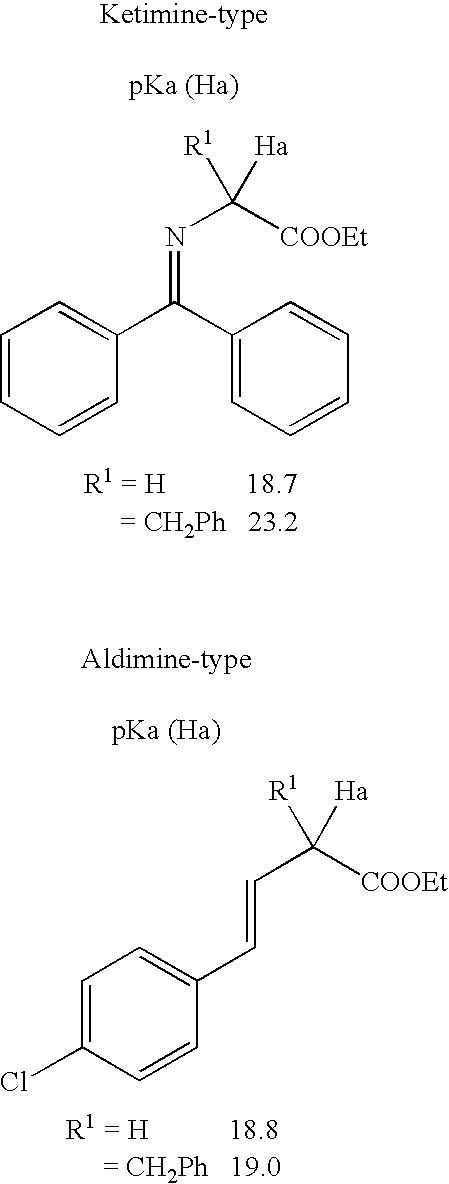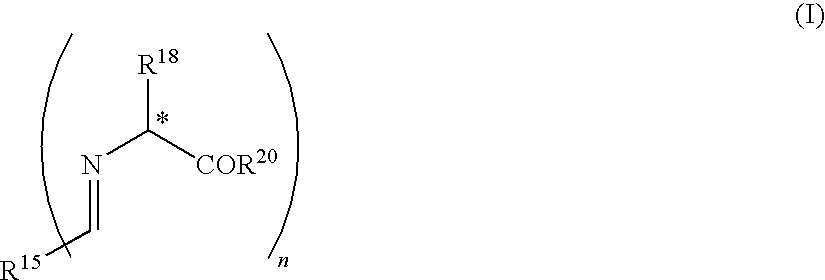Process for production of mono-substituted alkylated compound using aldimine or derivative thereof
a technology of mono-substitution and alkylated compounds, which is applied in the direction of organic compounds/hydrides/coordination complex catalysts, physical/chemical process catalysts, organic chemistry, etc., can solve the problems of high cost of -amino acids produced by asymmetric mono-substitution alkylation, complex manufacturing of ketimine-type schiff bases, etc., and achieves the effect of less cos
- Summary
- Abstract
- Description
- Claims
- Application Information
AI Technical Summary
Benefits of technology
Problems solved by technology
Method used
Image
Examples
reference example 1
Synthesis of Benzaldehyde Schiff Base of Glycine Ethyl Ester (Compound 3)
[0719]
[0720]Glycine ethyl ester hydrochloride (compound 1) (34.9 g; 250 mmol) was added to ethanol (500 mL), then triethylamine (25.3 g; 250 mmol) was added thereto, and the mixture was stirred. Further, benzaldehyde (compound 2) (25.4 g; 244 mmol) dissolved in ethanol (500 mL) was added dropwise to the ethanol mixture of the compound 1. The reaction mixture was stirred at room temperature for two hours, and then the ethanol was removed under reduced pressure. Half-saturated saline (200 mL) was added to the residue, and this was extracted with ethyl acetate (150 mL×2) and the ethyl acetate layer was collected. The ethyl acetate layer was dried over sodium sulfate and then concentrated under reduced pressure to give the title compound 3 (46.0 g; slightly yellow oil, yield 96%). The NMR spectrum of the obtained compound 3 is shown in Table 1.
TABLE 1NMR spectrum of compound 3400 MHz 1H-NMR (CDCl3): δ 8.21 (1H, s, ...
reference example 2
Synthesis of p-anisaldehyde Schiff Base of Glycine Ethyl Ester (Compound 13)
[0721]Using p-anisaldehyde instead of benzaldehyde of Reference Example 1, the compound 13 (yield 89%) was prepared. The NMR spectrum of the obtained compound 13 is shown in Table 2.
TABLE 2NMR spectrum of compound 13400 MHz 1H-NMR (CDCl3): δ 8.30 (1H, s, CH═N), 7.74-7.70 (2H, m),6.95-6.92 (2H, m), 4.36 (2H, s, N—CH2—C), 4.23 (2H, q, J = 7.2 Hz,O—CH2—C), 3.82 (3H, s, O—CH3), 1.30 (3H, t, 7.2 Hz, C—CH3)
reference example 3
Synthesis of p-chlorobenzaldehyde Schiff Base of Glycine Ethyl Ester (compound 15)
[0722]Using p-chlorobenzaldehyde instead of benzaldehyde of Reference Example 1, the compound 15 was prepared (yield 87%). The NMR spectrum of the obtained compound 15 is shown in Table 3.
TABLE 3NMR spectrum of compound 15400 MHz 1H-NMR (CDCl3): δ 8.25 (1H, s, CH═N), 7.77-7.70 (2H, m),7.45-7.38 (2H, m), 4.40 (2H, s, N—CH2—C), 4.24 (2H, q, J = 7.2 Hz,O—CH2—C), 1.30 (3H, t, 7.2 Hz, C—CH3)
PUM
| Property | Measurement | Unit |
|---|---|---|
| optical purity | aaaaa | aaaaa |
| time | aaaaa | aaaaa |
| optical purity | aaaaa | aaaaa |
Abstract
Description
Claims
Application Information
 Login to View More
Login to View More - R&D
- Intellectual Property
- Life Sciences
- Materials
- Tech Scout
- Unparalleled Data Quality
- Higher Quality Content
- 60% Fewer Hallucinations
Browse by: Latest US Patents, China's latest patents, Technical Efficacy Thesaurus, Application Domain, Technology Topic, Popular Technical Reports.
© 2025 PatSnap. All rights reserved.Legal|Privacy policy|Modern Slavery Act Transparency Statement|Sitemap|About US| Contact US: help@patsnap.com



